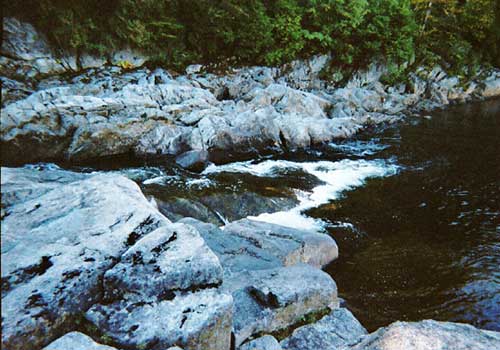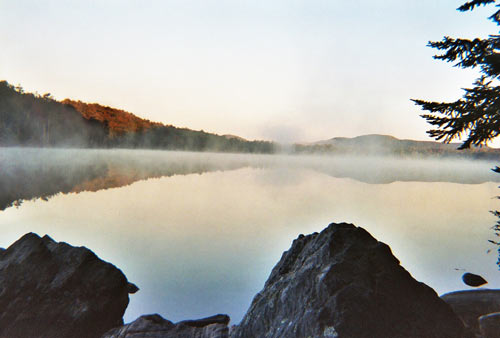
Above Big Eddy
That night we pushed on to Spruce Lake, which is a spot of exceptional beauty. We stayed in the vicinity of the second lean-to. In actual fact, I slept in it, having decided that, after avoiding lean-tos for so many years, I should give it a try to see if the experience agreed with me. Sleeping on a thin Z-Rest, it didn’t. There was clearly another party in the vicinity—we could see their distant fire—but one of the enigmas of the evening was a series of red flares off to the west. They were too widely spaced along a distant ridge for an emergency (not that we could have helped in any case) and I wondered if there was a military exercise in progress. We had seen large helicopters and planes overhead at various points in the day. This business remains a puzzle. Another phenomenon, less obvious but equally curious, were the loud splashes we heard at intervals. Lunkers? Moose? Mermaids?
The night was beautiful, with moonlight framed by the lean-to opening, and an extraordinary chorus of loons and coyotes in the night. The following morning a family of the birds made their appearance during breakfast, an enchanting sight. This is a place to which I would return like a shot.
The following day, we pushed on through the West Canada Lakes region, where we stayed at the northern end of the Cedar Lakes. West Lake en route was a charmer, and I would have happily rested there under other circumstances, but we needed the distance in order to keep our mileage on succeeding days reasonable. The Cedar Lakes showed signs of over-heavy use, with many small informal campsites interconnected by paths, though I was aware of only one other group in the area, a family with children at lean-to 4. This was a pleasant enough area to stay, but it must be party central in summer and the sense of wildness was lacking after the more remote lakes.
Worse was to come on the morrow, when we arrived at Wakely Dam. This is easily road-accessible and there were hordes of Winnebagos and the like. Early bear season had just begun. The shock of coming out of a wilderness area into a spot like this should not be underestimated. “Where only man is vile,” the words of the old hymn are what sprung first to mind. Of course, this is all very unjust, but it is indicative of how quickly one adapts to the wild and how one comes to resent human impact when it is so blatant.
Wakely Dam is clearly a sacrifice area for the DEC, and I very much wish the trail were directed away from it, particularly as what comes next is a longish road-walk, with much rapid, dusty traffic to and from the dam, the road ultimately passing through an area that is rapidly gentrifying. Twenty years ago this must all have been lovely, but now it is a mess (since first writing this I have learned that a re-route is in the works). That day we pushed eighteen miles to get beyond settlement and back to the true trail, ending up somewhat footsore at Stephens Pond, a pleasant spot that felt once more remote from humanity.
Interestingly, what began to be apparent at this point was that the ten-day itinerary noted in the ADK handbook, of which we had been inclined to be dismissive, was in fact pretty close to what we were being forced to follow by circumstance. This pattern largely persisted through the trip. The handbook itself, despite revisions, is in many specifics inaccurate, but it does seem to gauge matters regarding mileage rather well.
Having paused briefly in the morning at Lake Durant Campgrounds for a clean up (hot running water on demand, how extraordinary), our stop the following day was Tirrell Pond, one of the few lakes that are still open to floatplanes. In consequence, despite being extremely pretty, with a true beach at the northern end and a fine view of Tirrell Mountain and its cliffs, there is more impact than one might desire from hunters and overnighters who fly in.
The pilot who operates out of Long Lake actually showed up that evening to pick up some canoes, and we invited him over for a chat. A decent and amiable fellow, clearly very hard working, he was naturally aware of the problems that some of his clients cause. The planes do take garbage out and they are not the only source of traffic—this is a popular spot, so to blame overuse on them alone is unfair. There’s also something rather intriguing about seeing a floatplane splash down. We found a five-pound jar of peanut butter just discarded by the trail, unlikely to have originated with a backpacker. The fact that it had not been savaged at least reassured us that there were no bears then in the vicinity.
The next day we ascended the pass over the 3000-foot Blue Ridge (just S. of Burnt Mountain, this is the longest climb on the trail) in a light drizzle and descended down into the town of Long Lake. There we decided to stay at the Adirondack Hotel. This gave us a chance to remove any remaining trail grime and stink, deal with our food drop, do some hand laundry and have a dinner that was not out of a packet. Long Lake’s a nice spot, one that I have visited before, and the bar at the Hotel has Lake Placid’s Ubu Ale on tap, a distinct plus (a good microbrewery product). Definitely not a wilderness experience, although the rooms, despite ample fluffy towels and good linen, are a bit run down. Personally, I think the place exudes genuine period charm and I felt rather like French Louie (the tutelary spirit of the area) come into town for a fiesta.
[continued]

Morning mistdevil on Spruce Lake